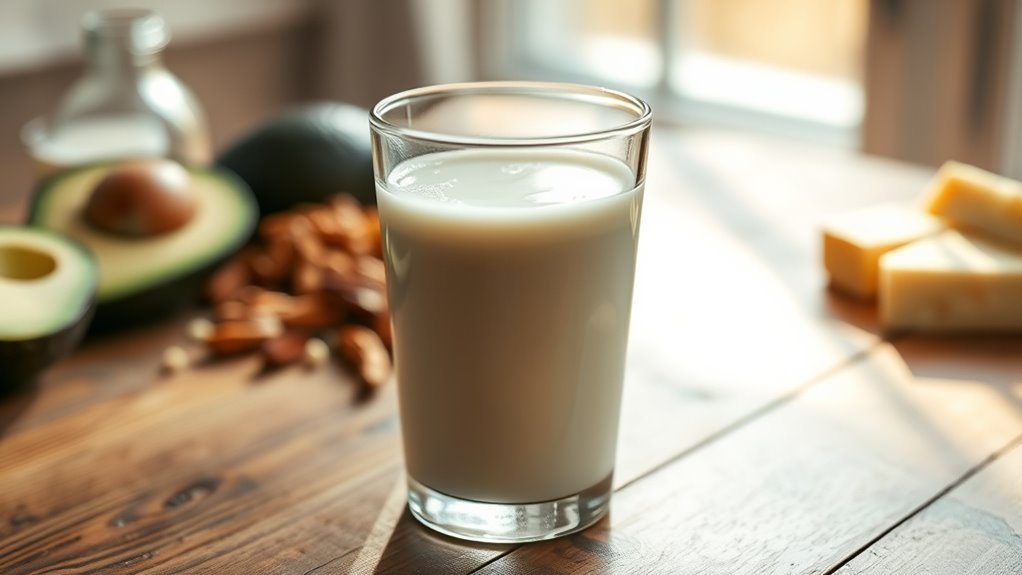Milk can be tricky on a keto diet due to its carb content. Whole milk has about 12 grams of carbs per cup, which might be too high for your daily carb limit. If you’re considering milk, opt for low-carb alternatives like unsweetened almond milk or coconut milk, which contain only 1 to 7 grams of carbs per cup. Keep an eye on portion sizes to stay within your goals. There’s more to explore about milk choices and keto.
Understanding the Keto Diet Basics

When you consider the keto diet, it’s vital to understand its fundamental principles. At its core, the keto diet focuses on drastically reducing carbohydrate intake while increasing fat consumption. This shift encourages your body to enter a state of ketosis, where it burns fat for fuel instead of glucose. You’ll need to be mindful of dietary restrictions, as certain foods can easily derail your progress. Emphasizing healthy fats like avocados, nuts, and olive oil is essential, while minimizing grains, sugars, and starchy vegetables is key. Balance is important; you don’t want to miss out on necessary nutrients. By grasping these keto fundamentals, you’re better equipped to make informed choices that align with your goals and support your freedom in dietary preferences.
Nutritional Profile of Different Types of Milk

Understanding the nutritional profile of different types of milk is important for anyone following a keto diet. When you look at nutritional comparisons, whole milk contains about 12 grams of carbs per cup, while almond milk has only 1 gram, making it a popular choice for keto enthusiasts. Coconut milk, depending on its type, can range from 6 to 7 grams of carbs per cup. On the other hand, unsweetened soy milk offers around 4 grams. These milk variations provide different fat and protein levels too, so it’s essential to evaluate your overall macronutrient goals. By choosing wisely among these options, you can enjoy milk while staying aligned with your keto lifestyle.
Impact of Lactose on Ketosis

Although lactose is a natural sugar found in milk, its presence can considerably impact your ability to maintain ketosis. When you consume milk, your body undergoes lactose metabolism, breaking down the sugar into glucose. This conversion can lead to increased blood sugar levels, which may hinder your ketosis efforts. If you’re aiming to stay in a state of ketosis, the ketosis effects of consuming lactose-rich dairy products can be significant. It’s crucial to monitor your intake of these products to guarantee they don’t disrupt your low-carb lifestyle. You might find that opting for low-lactose or lactose-free alternatives can help you enjoy dairy while still supporting your ketogenic goals. Balancing enjoyment and dietary needs can give you the freedom you seek.
Low-Carb Milk Alternatives
If you’re looking to enjoy milk while sticking to a low-carb diet, there are several alternatives that can fit seamlessly into your ketogenic lifestyle. These options not only cater to various taste preferences but also offer different levels of nutrient density. Here are some great choices:
- Almond milk (unsweetened)
- Coconut milk (unsweetened)
- Cashew milk (unsweetened)
- Hemp milk
- Macadamia nut milk
These alternatives can provide a creamy texture without the carbs associated with dairy milk. Keep in mind that the nutrient density varies, so choose those that align with your dietary goals. Experimenting with different options can help you find the perfect fit for your recipes and beverages, ensuring you stay satisfied while enjoying your low-carb journey.
Portion Control and Moderation
When incorporating low-carb milk alternatives into your diet, portion control and moderation play a significant role in maintaining your ketogenic lifestyle. It’s essential to be aware of portion sizes; even low-carb options can add up if consumed in excess. For instance, unsweetened almond milk is lower in carbs compared to regular milk, but drinking too much can still impact your daily carb limit. Practicing mindful consumption helps you enjoy these alternatives without derailing your goals. Measuring out servings or using smaller containers can make a big difference. Remember, freedom in your diet comes from understanding how to balance your choices, allowing you to savor the benefits of low-carb milk while staying true to your ketogenic path.
Individual Dietary Goals and Preferences
When considering whether milk fits into your keto diet, it’s important to reflect on your personal nutritional objectives. If you’re lactose intolerant, you’ll need to think about alternatives that provide similar benefits without causing discomfort. Understanding these factors can help you make informed choices that align with your dietary preferences.
Personal Nutritional Objectives
As you navigate the keto diet, understanding your personal nutritional objectives is essential for success. Your goals may vary, so it’s vital to define what you want to achieve while maintaining a nutritional balance. Here are some considerations to help you align your diet with your personal goals:
- Weight loss or maintenance
- Improved energy levels
- Enhanced mental clarity
- Specific health conditions (like diabetes)
- Enjoyment of diverse food options
Lactose Intolerance Considerations
If you’re lactose intolerant, incorporating milk into your keto diet can pose challenges, but it’s not impossible. Lactose intolerance symptoms like bloating and discomfort can make traditional dairy a poor choice for you. Fortunately, there are numerous dairy alternatives that fit into a keto lifestyle, such as almond milk, coconut milk, or cashew milk. These options are often lower in carbs and can be used in recipes or enjoyed on their own. You might also consider lactose-free dairy products, which provide the same taste without the discomfort. Remember, it’s essential to find what works best for your individual dietary goals, ensuring you maintain balance while still enjoying your meals. That way, you can thrive on your keto journey, free from discomfort.
Tips for Incorporating Milk on a Keto Diet
When incorporating milk into your keto diet, it’s crucial to choose low-carb options like unsweetened almond milk or heavy cream. Additionally, monitoring your portion sizes can help you stay within your daily carb limits while still enjoying the benefits of dairy. By being mindful of these factors, you can effectively include milk without compromising your keto goals.
Choose Low-Carb Options
Although incorporating milk into a keto diet can be tricky due to its carbohydrate content, there are several low-carb options that can fit seamlessly into your meal plan. Here are some suggestions to take into account:
- Unsweetened almond milk
- Coconut milk (full-fat)
- Heavy cream (in moderation)
- Low carb yogurt (like Greek yogurt)
- Keto friendly cheese (such as cheddar or mozzarella)
These alternatives allow you to enjoy creamy textures and flavors without derailing your carb count. When selecting dairy products, always check nutritional labels to verify they align with your keto goals. By choosing low-carb options, you can maintain dietary freedom while still indulging in delicious milk-based treats.
Monitor Portion Sizes
While it’s important to choose low-carb milk options for a keto diet, monitoring portion sizes is equally essential to guarantee you stay within your carbohydrate limits. Even low-carb milk can add up quickly if you’re not careful. By tracking your intake, you can enjoy milk without derailing your progress. For example, a splash of unsweetened almond milk in your coffee can be a great addition, but pouring too much might push you over your daily carb allowance. Aim for mindful consumption; consider measuring out servings to keep yourself accountable. This way, you can enjoy the creamy texture and flavor of milk while still adhering to the principles of a ketogenic lifestyle. Remember, freedom in your diet comes from balance and awareness.


